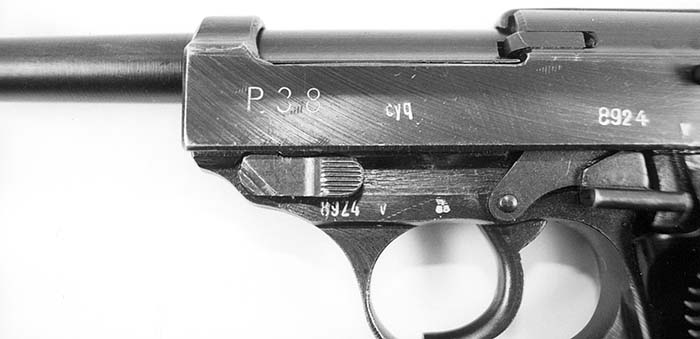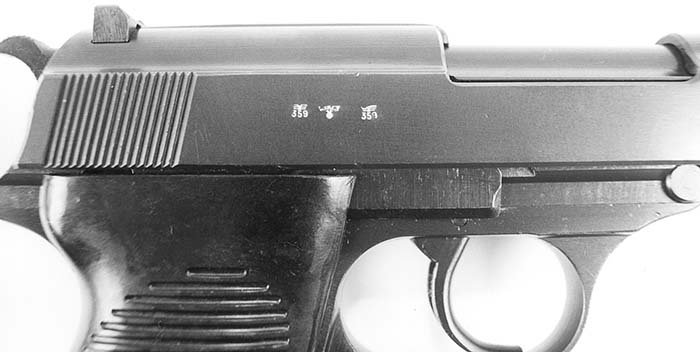A wartime P.38 manufactured by the Walther Company (ac code) in 1942.
By Frank Iannamico
One of the most famous military pistols of all time is arguably the P.08 Luger. The Luger has often been recognized as the standard issue handgun of the German Wehrmacht. The Luger was actually the standard German pistol of World War One and issued in great numbers during that conflict. Although the Luger continued to be manufactured during the Second World War, the P.38 was the predominant German pistol from 1940 to 1945. The double action P.38 was much better suited for military use than the labor intensive Luger. The P.38 was issued to all branches of the German military during the war. The Germans used a large variety of handguns during WWII. Other pistols issued to the German troops like the Belgium Browning Hi-Power and the Polish Radom were produced by forced labor in countries that the Nazis had occupied.
Walther Waffenfabrik of Zella-Mehlis designed and developed the P.38. The P.38 was preceded by two prototypes; the MP Militar Pistole and AP Armee Pistole, both of these designs were rejected by the German Army. The Walther Company had been briefly closed shortly after the conclusion of WWI because of the restrictive treaty of Versailles that disallowed the Germans from developing or manufacturing firearms. The company reopened in 1920 and began to produce handguns for the civilian and police market. During the 1930s many militant groups within Germany were secretly rearming in preparation for a revolution against the countries that had plunged the country into post war chaos. Walther, like most other German firearm manufacturers, was quietly developing weapons for the military. The P.38 double-action design was patented in January of 1938. The prewar P.38s were offered as the Heeres Pistol or HP model and sold on the civilian market. The HP was beautifully fitted and finished. The pistol was offered and exported to quite a few countries including the United States. The Walther pistol was offered in several calibers including 9mm, 7.62 Parabellum (.30 Luger) and .45 ACP. The retail price of the HP pistol was quite expensive and few were sold.
The P.38 was the third production double-action pistol design built by Walther (the P.38 was preceded by the PP and PPK models). The pistol was very advanced for the time. The conventional double-action design allowed a round to be safely carried in the chamber. The pistol could be quickly fired by simply pulling the double-action trigger. Subsequent shots would be fired with the hammer back (single-action). There were a few minor changes in the design once production had begun. One modification was made to the firing pin, changing it from a triangle configuration to an easier to manufacture round type. The other change was to the extractor. The original extractor design was considered difficult to clean and was redesigned to the exposed style. The rear sight is a large rear U notch, the front sight is a triangle shaped affair that can be drifted right or left if necessary. A slide-mounted “hammer drop” safety operates opposite the U.S. 1911. On the P.38 the fire or feuer position is obtained by pushing the lever upward. Safe or Sicher position is down. In 1943 the frame was redesigned to be strengthened around the trigger pin. A slight bulge extending down into an otherwise symmetrical trigger guard can easily identify these pistols. The all steel P.38 weights 34 ounces unloaded. An eight round capacity magazine is positioned inside the grip. The magazine release lever is the awkward “European” style located at the base of the grip. A six-groove 1:10 twist barrel is 4 15/16 inches in length. The overall length of the pistol is 8 7/16 inch. A loaded chamber indicator was incorporated in the design. The indicator pin protrudes from the rear of the slide when the weapon is loaded, and could be easily felt with a fingertip at night. One characteristic of the P.38 that many American shooters find unique is that it ejects spent cases out of the left side of the slide. A black or brown leather holster of varying styles was issued for carrying the pistol.

Walther P.38 pistols were produced in several variations that differed mainly in finish and markings. The first ones produced for the military contracts were similar to those made for the civilian market. The early contract pistols are known by collectors as the zero series, because of the zero first digit in the serial number. The slides on these pistols featured the Walther name and banner. The zero series was followed by the newly assigned Walther wartime code 480. The 480 code appeared only briefly until the Germans changed from numeric to letter codes. Walther P.38s were assigned the letter code ac. Slide markings on Walthers were subsequently marked with the letter code ac followed by a two digit number designating the year the particular weapon was manufactured. A number of P.38 pistols were sold to Sweden for their military. Those pre-war pistols are identified by an H on the frame. The Swedish issue P.38 was designated as the M39 pistol.

After the German Wehrmacht officially adopted the P.38, civilian and export sales were suspended and all available production went to the military. As WWII escalated the demand for sidearms grew. Walter’s production could not keep up with the demand and new companies were contracted to produce the pistol. Mauser-Werke at Oberndorf, who was also manufacturing the P.08 Luger, began tooling up to produce the P.38. By November of 1942, the first Mauser manufactured P.38s were coming off the assembly lines. Mauser had been experimenting with a phosphate finish for their pistols and many that were manufactured by them had components, and even complete pistols that were phospated in a gray color. Mauser produced pistols were marked with the manufacturing code byf and the Waffenampt inspector’s mark 135. While most wartime P.38s had brown or black plastic grips, Mauser installed stamped sheet metal grips on some weapons. Mauser also made the P.38 for the German police; the markings are different on the police contract pistols. In 1945 Mauser’s manufacturer code was changed to SVW.

Spreewerk, a third manufacturer, was selected in 1943 to begin production of the P.38. The Spreewerk factory was manufacturing heavy artillery pieces. Mauser assisted Spreewerk in setting up their P.38 production line. The Spreewerk manufactured P.38s are recognized by the assigned factory code cyq, and Waffenampts WaA 88, although Spreewerk pistols were also assembled using Walther and Mauser parts. Pistols manufactured by Speewerk did not include the year of manufacture stamped on the slide. Spreewerk operated two factories that assembled the P.38, one in Czechoslovakia the other at Spandau, Germany. Like other P.38s the Spreewerk guns had a four-digit serial number with a letter suffix. After the letter z was reached, the lettering was started again at the letter “a” but as a prefix instead of a suffix. All P.38s have their serial numbers stamped on the frame, slide and barrel. Because of their efforts to expedite production, Spreewerk pistols normally have a rougher machine finish with excess tool marks. By December of 1943 completed Spreewerk pistols were being sent into service. Late manufacture Spreewerk pistols, like the early Walther manufactured P.38s also had a limited run of “zero” prefix serial numbers, these pistols were hastily manufactured as Russian troops were closing in on the factory in the spring of 1945.

After the Allies captured the Mauser factory, manufacture of the P.38 was temporarily halted, and the French occupied the factory. The French being short on weapons for their police and occupation troops soon resumed production of the pistol. The French began assembling pistols from the parts that were left inside the factory.
The French P.38s are identified by a five point star stamped on the left side of the slide. The pistols also retained the Mauser code SVW, usually marked with the year 45 or 46. The pistols destined for police use were blued while the military guns were finished in a gray phosphate. Collectors refer to the latter guns as “Gray Ghosts”. The French P.38s eventually found their way to Indo China and Algiers in the holsters of French troops.
When the Spreewerk and Walther plants were taken over by the Allies, there were enough parts remaining to assemble a fair amount of additional P.38 pistols. After the war had ended the Czechs and East Germans, like the French, opened the factories to assemble complete pistols from the parts. The Czech pistols were stamped with that country’s Rampant Lion symbol. The pistols were used for issue to the police and military. The East German Police (Vopo) P.38s were marked with a “sunburst” stamp and/or a crown, and various letters or numbers. Beginning in 1957 Walther began to manufacture the P.38 design once again. A new alloy frame post war model was introduced as the P1. The pistol was for police and military sales. In 1962 Walther began offering the P1 to the civilian market.
The P.38 was quite an advanced military handgun for its time. Those familiar with the U.S. Army’s current issue M9 pistol will see quite a few similarities between the two designs. The WWII P.38 can be easily located on the collector market and is usually very reasonably priced when compared to other weapons of the era. There are enough variations of the pistol to intrigue any collector.
| This article first appeared in Small Arms Review V4N9 (June 2001) |












